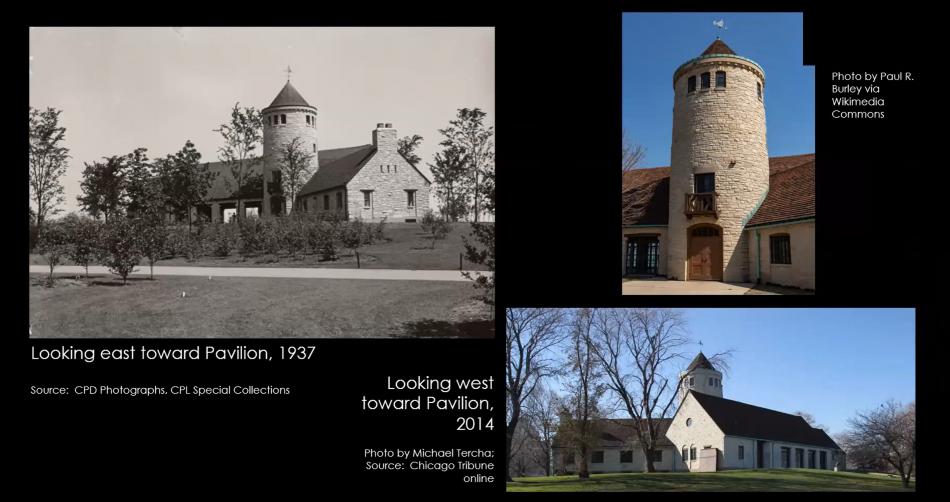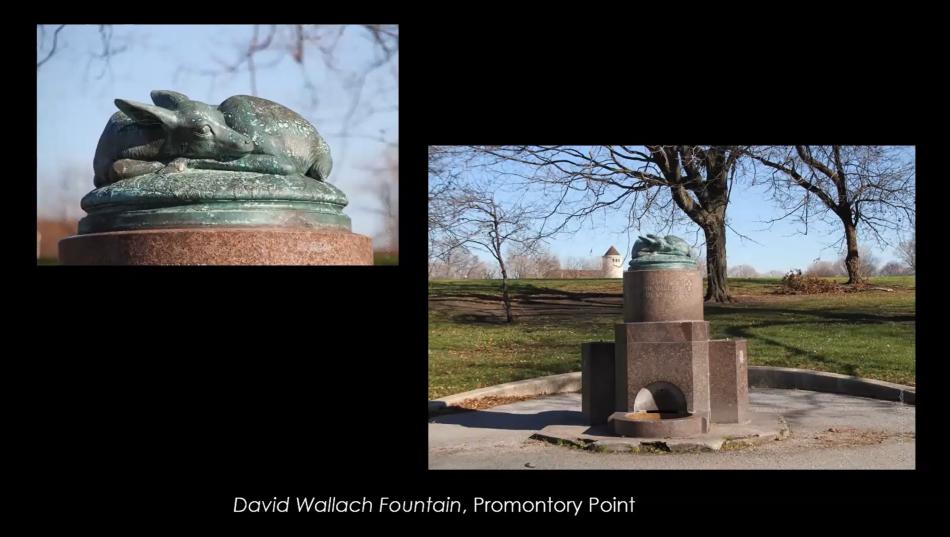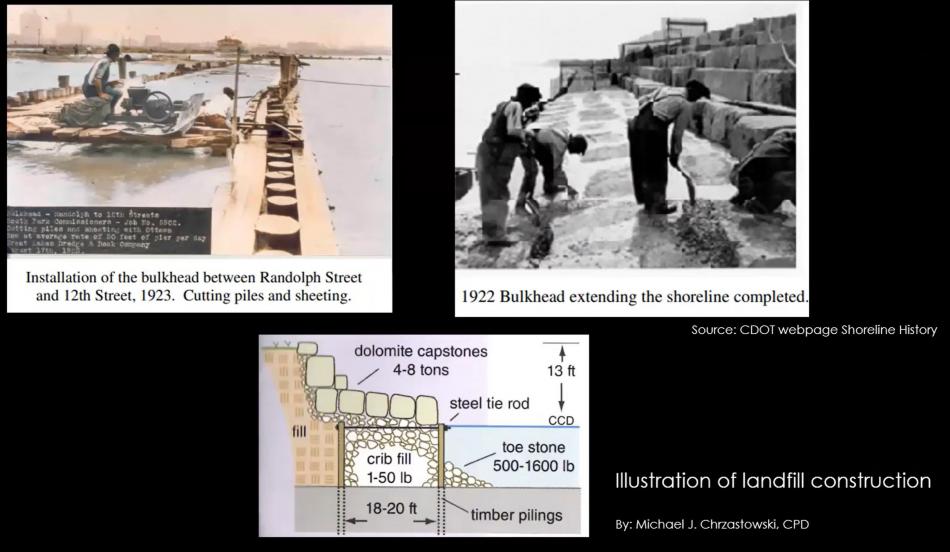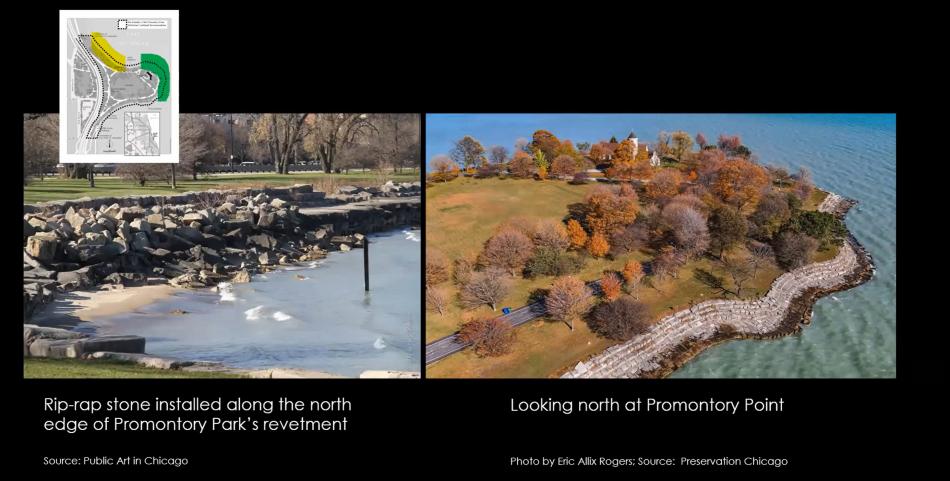The Commission on Chicago Landmarks has approved a preliminary landmark designation for Promontory Point. Located east of Jean Baptiste Point du Sable Lake Shore Drive, the promontory sits between 54th and 56th streets in Hyde Park. Built in the 1920s and 30s, the parkland is a peninsula of artificial landfill whose landscaping was designed by Alfred Caldwell.
The curving landform is surrounded by the last remaining limestone revetments along the entire lakefront, providing views of the city and access to the lake. A circular path goes around the promontory with a large, open meadow in the center. Important features include the pavilion building designed by Emmanuel V. Buchsbaum, the David Wallach Fountain by sculptors Frederick C. Hibbard and Elizabeth Hazeltine, and four council rings designed by Caldwell.
Landmarks staff determined that Promontory Point meets four criteria for landmarking, including Criterion 1 for heritage. Built as part of Burnham’s ambitious lakefront expansion, Promontory Point was an integral part of the development of new green space in the early 20th century. To create the land, revetments were installed. The process began by driving wood piles into the lake and tying them together with steel bands. The cribs as they called them were filled in with stones and once the site behind it was infilled, cut limestone blocks were set on top of those cribs and up against the new landfill to prevent erosion. After the Great Depression, WPA funds from the New Deal helped fund the completion of Promontory Point and the construction of the pavilion building.
The next criterion is Criterion 4 for exemplary architecture. Alfred Caldwell was tapped to design Promontory Point, where he created a scene of an open meadow framed by irregular groupings of greenery that gave a sense of enclosure and framed views out towards the lake and city. This center space drastically contrasted with the limestone revetments that edged the perimeter. Emmanuel Buchsbaum, who was the Park District’s head architect, designed the pavilion building in a French Eclectic style that was uncommon for the era. The building was designed with a round tower and conical roof at the intersection of two asymmetric gabled roof wings.
The Point also meets Criterion 5 for being the work of significant architects and designers. Alfred Caldwell was a great 20th century landscape designer whose tenure included time at the Chicago Park District where he was quickly given the most ambitious and high-profile projects due to his knowledge and design skills. Emmanuel V. Buchsbaum began his career as a draftsman before he spent almost his entire career at the Chicago Park District except for a few years where he worked on the State Street subway. Frederick C Hibbard and Elizabeth Hazeltine were husband and wife artists who both studied at the School of the Art Institute before working on a wide body of work that extends around the country.
The final criterion is Criterion 7 for its unique or distinct visual features. Although landfill created new green space from Grant Park to Jackson Park, Promontory Point is the only peninsula on the lakeshore. From its earliest days, Chicagoans have used it for all kinds of group outings, gatherings, and recreation.
As set forth by the landmarks staff, the designation would protect all exterior elevations and rooflines of the pavilion building, as well as the pathways, council rings, the David Wallach Fountain, and the limestone revetments. Plantings and trees have been specifically excluded at this time. The next step for the designation would be a report and final landmark recommendation from the commission which could come as soon as next month. If there are no issues, the City Council could adopt the landmark designation by the end of April.
Once the presentation ended, the hearing turned into a heated discussion between city officials and preservationists about the details of the plan for repairing the limestone. Local alderman Leslie Hairston criticized the Park District and CDOT for leaving her out of discussions about next steps for the limestone revetments and for a plan to replace the limestone with concrete that was apparently included in an unreleased document from CDOT and SmithGroup. This document was found out to be the Lakefront Strategic Action Plan that was contracted with SmithGroup back in 2019.
Hairston said, “If this [project] is to be done in anything other than limestone, it is a no-go for the community.” Park District and Department of Transportation officials both went on the record in the meeting to say they’re “in complete agreement” with the community and will be pursuing the locally preferred plan. To this Jack Spicer, Founder of Promontory Point Conservancy, criticized that the “locally preferred plan” was to demolish the limestone and replace it with concrete which was absolutely not the community’s preferred plan.
CDOT Deputy Commissioner Dan Burke who joined the call on short notice pushed back on Spicer’s reference to what was apparently a plan from all the way back in 2005 saying, “Can we stop discussing 2005? Let's put it to rest," Burke said. “We’re committed to a plan reusing the existing limestone and doing it as part of a rehabilitation that will be consistent with the Secretary of Interior’s standards for historic preservation.”
Park District representative Heather Gleason also reaffirmed their commitment saying, “I understand the community’s fear about it, but I want to be clear: The Chicago Park District, as the property owner of Promontory Point, our intention is to follow the community’s wishes to maintain and preserve the limestone.”
Moving on, the commission voted to approve the landmark designation and the meeting ended. With this landmark status moving forward, the ultimate designation would then require any work proposed for Promontory Point to be reviewed by landmarks staff prior to anything being done on the site.











